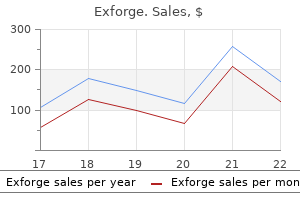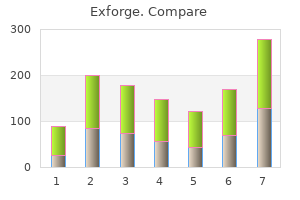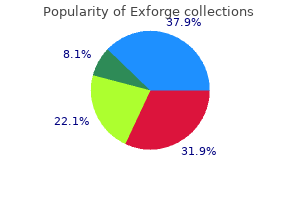Exforge

"Cheap 80mg exforge free shipping, arrhythmia update".
G. Ford, M.S., Ph.D.
Program Director, Dartmouth College Geisel School of Medicine
Decreases in one or more cell lineages could indicate hypersplenism blood pressure ranges female buy cheap exforge 80mg online, increased destruction arterial blood gas values order 80mg exforge mastercard. In cases with hypersplenism hypertension htn purchase exforge 80 mg, the spleen is removed and the cytopenia is generally reversed blood pressure chart home use cheap 80 mg exforge otc. Individuals who have had splenectomy are at increased risk of sepsis from a variety of organisms including the pneumococcus and Haemophilus influenzae. The essential ocular exam includes assessment of the visual acuity, pupil reactions, eye movements, eye alignment, visual fields, and intraocular pressure. The lids, conjunctiva, cornea, anterior chamber, iris, and lens are examined with a slit lamp. Acute visual loss or double vision in a pt with quiet, uninflamed eyes often signifies a serious ocular or neurologic disorder and should be managed emergently (Chap. Ironically, the occurrence of a red eye, even if painful, has less dire implications as long as the visual acuity is spared. Minor Trauma this may result in corneal abrasion, subconjunctival hemorrhage, or foreign body. The integrity of the corneal epithelium is assessed by placing a drop of fluorescein in the eye and looking with a slit lamp or a blue penlight. Corneal abrasions may require application of a topical antibiotic, a mydriatic agent (1% cyclopentolate), and an eye patch for 24 h. On slit-lamp exam one should confirm that the cornea is not affected, by observing that it remains clear and lustrous. Corneal infection (keratitis) is a more serious condition than blepharoconjunctivitis because it can cause scarring and permanent visual loss. A localized abscess or ulcer within the cornea produces visual loss, pain, anterior chamber inflammation, and hypopyon. A dendritic pattern of corneal fluorescein staining is characteristic of herpes simplex keratitis. Keratitis requires empirical antibiotics (usually topical and subconjunctival) pending culture results. Herpes keratitis is treated with topical antiviral agents, cycloplegics, and oral acyclovir. Inflammation Eye inflammation, without infection, can produce episcleritis, scleritis, or uveitis (iritis or iridocyclitis). A ciliary flush results from injection of deep conjunctival and episcleral vessels near the corneal limbus. The diagnosis of iritis hinges on the slit-lamp observation of inflammatory cells floating in the aqueous of the anterior chamber (cell and flare) or deposited on the corneal endothelium (keratic precipitates). Because the anterior chamber is shallow, aqueous outflow via the canal of Schlemm becomes blocked by the peripheral iris. Intraocular pressure rises abruptly, causing ocular pain, injection, headache, nausea, and blurred vision. The key diagnostic step is measurement of the intraocular pressure during an attack. It is treated by surgical extraction and replacement with an artificial intraocular lens. It is associated with elevated intraocular pressure, but many pts have normal pressure. Angle closure accounts for only a few cases; most pts have open angles and no identifiable cause for their pressure elevation. The diagnosis is made by documenting arcuate (nerve fiber bundle) scotomas on visual field exam and by observing "cupping" of the optic disc. In the dry form, clumps of extracellular debris, called drusen, are deposited beneath the retinal pigment epithelium. In the wet form, neovascular vessels proliferate beneath the retinal pigment epithelium.

The test should be performed with caution heart attack names discount exforge 80mg with visa, however heart attack keychain cheap exforge 80 mg with amex, because of the risk of compartment syndrome with ulnar nerve damage or severe rhabdomyolysis that may lead to renal failure blood pressure medication patch generic 80mg exforge fast delivery. In patients with coenzyme Q10 deficiency heart attack album buy exforge 80 mg free shipping, complete recovery may occur with oral coenzyme Q10 supplementation at a dose of 150 mg/d. Acute myoglobinuric renal failure and life-threatening electrolyte disturbances are the most dreaded complications. In severe cases, treatment may require peritoneal dialysis or hemodialysis; patients with milder disease can be treated with aggressive hydration, alkalinization of urine with sodium bicarbonate, and correction of electrolyte disturbances. Patients with myoglobinuria typically present with weakness, myalgias, and edema involving affected muscles. Urine is characteristically brownish to dark red and tests positive for heme by the dipstick test despite the absence of red blood Channelopathies are rare diseases caused by functional disturbances of ion channel proteins as a result of specific mutations. These disorders include the familial periodic paralyses and disorders with myotonia. General Considerations Congenital muscular dystrophies can be separated into two groups: those associated with mental retardation and those associated with normal mental development. There is no specific treatment for the congenital muscular dystrophies, and management focuses on supportive care and rehabilitation therapy. Special Tests for Periodic Paralysis In all forms of periodic paralysis, muscle biopsy may show vacuoles within muscle fibers during severe attacks. These conditions can be distinguished from muscular dystrophies, which are caused by defects of the muscle membrane. Congenital myopathies usually manifest in infancy with delayed milestones or occur in the neonatal period (floppy infant syndrome) or, less commonly, in adulthood. Patients with central core myopathy, even in the absence of clinical weakness, are at risk for malignant hyperthermia during general anesthesia. Most cases are X-linked recessive, although 30% involve spontaneous new mutations. Symptoms and Signs No obvious abnormalities are seen at birth; however, delayed motor milestones may be apparent after the first year of life. Weakness progresses, causing children to fall frequently, and calves become enlarged (pseudohypertrophy). Contraction of Achilles tendons forces children to walk on their toes or on the balls of their feet. At this stage, patients employ Gowers maneuver to stand up from the floor: they rise from the floor by climbing up the thighs with their hands. Between the ages of 7 and 12 years, most patients lose their ability to walk and become wheelchair dependent. Fatty infiltration of the heart and respiratory infections often lead to death, which typically occurs by the end of the second decade. Lifethreatening vulnerability to malignant hyperthermia from anesthesia (halothane, succinylcholine) exists. Laboratory and Diagnostic Findings Most patients have abnormalities on electrocardiography. Diagnosis is confirmed by demonstrating severely reduced or absent dystrophin in a muscle biopsy specimen or a mutation in the dystrophin gene. This disorder is a milder allelic form of dystrophinopathy, with decreased or altered dystrophin rather than absence. Onset is usually after 12 years of age, and delayed onset after the fourth decade is occasionally seen. Life expectancy is reduced; however, most patients survive into the fourth or fifth decade. Phenytoin is preferred to quinine and procainamide in the treatment of myotonic dystrophy because it has fewer adverse effects on cardiac conduction. Careful follow-up of patients with cardiac conduction abnormalities is warranted, and pacemaker insertion may eventually become necessary. Patients with myotonic dystrophy are at risk for developing malignant hyperthermia during anesthesia. Trinucleotide repeats are found throughout the human genome and are normally stable through generations of the same pedigree. The number of repeats varies among healthy individuals, and their function is largely unknown. A direct correlation exists between the number of trinucleotide repeats and the age of onset and severity of disease.

Serum cryptococcal antigen and fungal cultures are sensitive tests for cryptococcemia pulse pressure 22 proven exforge 80 mg. In fact blood pressure medication to treat acne order exforge 80 mg with mastercard, serum cryptococcal antigen is detectable in the blood 3 weeks before meningitis onset and is an independent predictor of clinical meningitis and death hypertension nos discount exforge 80mg with visa. However blood pressure infant normal value buy cheap exforge 80 mg line, although a negative serum antigen test makes the diagnosis of cryptococcal meningitis unlikely, it does not rule it out. A focal neurologic finding, papilledema, or encephalopathy warrants an imaging study prior to lumbar puncture. Symptoms and Signs Nonspecific headache and fever are the cardinal features of cryptococcal meningitis. Nausea, vomiting, phonophobia, and photophobia (migraine symptoms) are rare early in the infection. In settings where flucytosine is unavailable, induction therapy with amphotericin B and fluconazole is recommended and has been positively associated with outcome. After induction treatment is completed, fluconazole, 200 mg/day orally, is continued as consolidation treatment. When intracranial pressure is elevated (>250 mm H2O), frequent lumbar punctures are indicated so long as brain imaging does not raise concern for impending herniation. Hydrocephalus can be a late manifestation of cryptococcal meningitis requiring permanent shunt placement. Most cases occur as a recrudescence of a latent infection of the small, intracellular protozoa Toxoplasma gondii, which is acquired through ingesting uncooked meat, contaminated water, or cat feces. Symptoms and Signs A subacute presentation with headache, fever, focal neurologic deficit(s), and altered mental status is the most common presentation. Rarely, toxoplasmosis presents with ocular pain and visual loss (toxoplasmic retinochoroiditis), myelopathic signs (spinal cord toxoplasmosis), or diffuse encephalitis. Unilateral chorea or ballism, along with other movement disorders, have been reported, with toxoplasmic abscesses in the basal ganglia. Laboratory and Imaging Studies A presumed clinical diagnosis is made by combining historical information with results from serum tests and brain imaging. However, individuals with positive titers are more than 35 times as likely to develop cerebral toxoplasmosis than those with negative titers. Mild-to-moderate pleocytosis, elevated protein concentration, and normal-to-low glucose level are the usual findings. Toxoplasma has a predilection for the basal ganglia and the gray-white junction of the hemispheres. In resource-limited settings trimethoprim (10 mg/kg/day) and sulfamethoxazole (50 mg/kg/day) for four weeks is often the treatment of choice, and emerging evidence indicates that this may be just as effective as the first-line agents more commonly used in better resourced settings. Acute therapy should continue for 6 weeks or until the lesions no longer enhance, whichever is later. If patients do not respond to the therapeutic trial of anti-toxoplasmosis therapy, a biopsy should be performed to evaluate for other causes of mass lesions (eg, tumor, bacterial abscess, tuberculoma, cryptococcoma). Laboratory and Imaging Studies If not contraindicated, lumbar puncture should be performed. However, a negative test does not exclude the diagnosis, and a positive test does not exclude a comorbid process such as toxoplasmosis. Enhancement tends to be heterogeneous rather than the ringlike appearance seen with toxoplasmosis. Signal intensity on T2-weighted images is variable, but is often bright on diffusion-weighted images. Perfusion-weighted images show areas of increased regional blood volumes, in contrast to the low-volume areas seen with toxoplasmosis. Biopsy provides a definitive diagnosis and should be considered in all suspected cases in which treatment with antitoxoplasma agents has not led to rapid radiographic or clinical improvement. Such patients usually require a biopsy for definitive diagnosis and resistance testing. Ancillary treatment with fractionated whole brain radiation therapy or chemotherapeutic agents such as methotrexate can also be used, but these decisions need to be made on a case-by-case basis in collaboration with an oncologist (see Chapter 12).

Treatment consists of bed rest heart attack racing 80mg exforge, sedation heart attack alley cheap 80 mg exforge with visa, control of neurologic manifestations with magnesium sulfate heart attack 42 year old buy generic exforge 80mg on line, control of hypertension with vasodilators and other antihypertensive agents proved safe in pregnancy pulse pressure treatment generic exforge 80 mg online, and delivery of the infant. Sickle Cell Nephropathy the hypertonic and relatively hypoxic renal medulla coupled with slow blood flow in the vasa recta favors sickling. Stone formation begins when urine becomes supersaturated with insoluble components due to (1) low volume, (2) excessive excretion of selected compounds, or (3) other factors. Approximately 75% of stones are Ca-based (the majority are Ca oxalate; also Ca phosphate and other mixed stones), 15% struvite (magnesiumammonium-phosphate), 5% uric acid, and 1% cystine, depending on the metabolic disturbance(s) from which they arise. Signs and Symptoms Stones in the renal pelvis may be asymptomatic or cause hematuria alone; with passage, obstruction may occur at any site along the collecting system. Obstruction related to the passing of a stone leads to severe pain, often radiating to the groin, sometimes accompanied by intense visceral symptoms. Hyperoxaluria may be seen with intestinal (especially ileal) malabsorption syndromes. Ca oxalate stones may also form due to (1) a deficiency of urinary citrate, an inhibitor of stone formation that is underexcreted with metabolic acidosis; and (2) hyperuricosuria (see below). Struvite stones form in the collecting system when infection with urea-splitting organisms is present. Uric acid stones develop when the urine is saturated with uric acid in the presence of dehydration and an acid urine pH. Hyperuricosuria without hyperuricemia may be seen in association with certain drugs. Cystine stones are the result of a rare inherited defect of renal and intestinal transport resulting in overexcretion of cystine. Stones begin in childhood and are a rare cause of staghorn calculi; they occasionally lead to end-stage renal disease. Workup Although some have advocated a complete workup after a first stone episode, others would defer that evaluation until there has been evidence of recurrence or if there is no obvious cause. Table 148-1 outlines a reasonable workup for an outpatient with an uncomplicated kidney stone. Careful medical history and physical examination, focusing on systemic diseases 3. Stone analysis is advisable, especially for pts with more complex presentations or recurrent disease. In contrast to prior assumptions, dietary calcium intake does not contribute to stone risk; rather, dietary calcium may help to reduce oxalate absorption and reduce stone risk. Table 148-2 outlines stone-specific therapies for pts with complex or recurrent nephrolithiasis. Consequences depend on duration and severity and whether the obstruction is unilateral or bilateral. It is preponderant in women (pelvic tumors), elderly men (prostatic disease), diabetic pts (papillary necrosis), pts with neurologic diseases (spinal cord injury or multiple sclerosis, with neurogenic bladder), or in individuals with retroperitoneal lymphadenopathy or fibrosis, vesicoureteral reflux, nephrolithiasis, or other causes of functional urinary retention. Clinical Manifestations Pain can occur in some settings (obstruction due to stones) but is not common. Physical exam may reveal an enlarged bladder by percussion over the lower abdominal wall. Urinalysis is most often benign or with a small number of cells; heavy proteinuria is rare. Calyceal dilation is commonly seen; it may be absent with hyperacute obstruction, upper tract encasement by tumor or retroperitoneal fibrosis, or indwelling staghorn calculi. It should be noted that unilateral obstruction may be prolonged and severe (ultimately leading to loss of renal function in the obstructed kidney), with no hint of abnormality on physical exam and laboratory survey. If technically feasible, ureteral obstruction due to tumor is best managed by cystoscopic placement of a ureteral stent. Otherwise, the placement of nephrostomy tubes with external drainage may be required. Circles represent diagnostic procedures and squares indicate clinical decisions based on available data. However, there may be an "inappropriate" natriuresis/diuresis related to (1) elevated urea nitrogen, leading to an osmotic diuresis; and (2) acquired nephrogenic diabetes insipidus.
